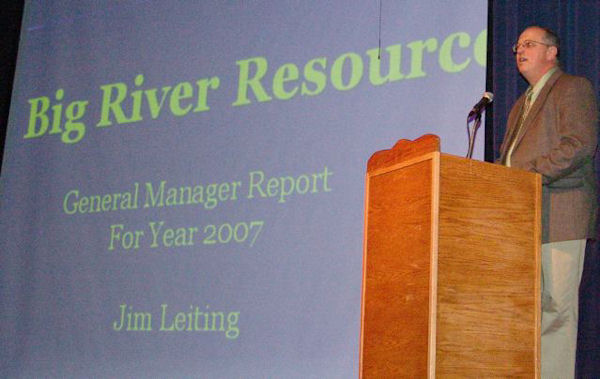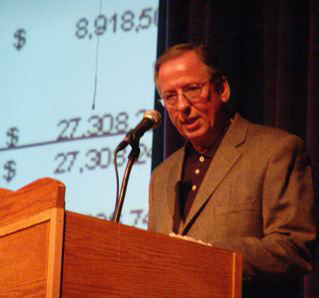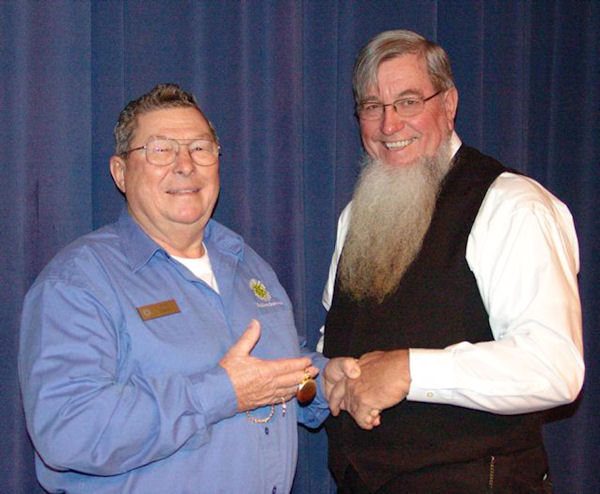
The Hancock-Henderson Quill, Inc.
by Dessa Rodeffer, Quill Publisher/Owner
Shareholders were again encouraged by profits reported by Big River Resources, LLC at their 5th Annual Meeting Saturday.
In spite of nay-sayers questioning the ethanol industry, Big River Resources showed stockholders that their risk management strategies combined with their good marketing techniques and investments in further growth, are making them a company of their word - to bring added value to their corn and their community.
Big River Resources Cooperative Annual Report showed that the Board of Directors and their selected management team know how to turn corn into cash at the tune of $130 million minus costs, leaving a gross net profit of over $31 million.
Over 50% of the net taxable profit was given back to Cooperative members, and over $10 million was put back into Big River Resources rural communities through shareholder dividends.
In addition, during the rise in corn usage through ethanol, prices for corn have risen from below $2.00 a bushel (pre ethanol), to prices which now approach $5.00. Over 95,000 bushel of corn is ground and used for ethanol production each day at the West Burlington, Iowa facility which runs 7 days a week, 24 hours a day.
Big River reported that they are now in the process of increasing profits even more by extracting oil from the syrup which will provide another income stream to the plant totally an estimated $3 million annually.
Roughly, over sixty employees now work for "Big River" with their salaries and income contributing to the welfare of the area, which is yet a third goal met by Directors.
In Jim Gunter's opening prayer in thanking God for these profits and successes, Gunter added: "Well done, good and faithful servants."
The plant at West Burlington produced 54 million gallons of ethanol and 155 thousand tons of DDGS using 19 million bushels of locally grown corn. Efficiency of the plant is measured by the fact that 2.9 gallons of ethanol is produced for every bushel of corn.
In terms of Western Illinois, for every 200 per acre field of corn produced, the farmer actually had 568 gallons of ethanol in that field.
CEO Ray Defenbaugh said that 417,000 barrels of ethanol are produced each day, about 17.5 million gallons... equivalent of three medium-sized crude oil refineries. The U.S. now has 141 ethanol facilities with the capacity to produce an impressive 8 billion gallons of ethanol annually.
The USDA forecasts net cash farm income in 2008 will hit $96.6 billion, up $9 billion from the record level registered in 2007. Net farm income is put at a record $92.3 billion vs. $88.7 billion in "07.
Net cash income is forecast to rise more than net farm income due to the large carryover of crops which will be sold in "08.
The farm income rise came despite the 6th straight increase in production expenses. USDA sees those costs rising $22.2 billion in "08 after a $24.5 billion jump in "07.
The new energy bill passed in December 2007, mandates corn based ethanol production of 15 billion gallons by 2015.
Defenbaugh stated, "Will the ethanol industry continue to grow?
"Yes... USDA puts 06-07 corn-for-ethanol use at 2.117 billion bu. and 2007-08 corn-for-ethanol use at 3.2 billion bu. and projects 4.1 billion bu. in 08-09 marketing year. That results in total corn-for-ethanol use in 2017-18 marketing year of 4.9 billion bushels!
At current efficiencies of about 2.9 gallons of ethanol per bu. of corn, that would produce 14.21 billion gallons of ethanol in the 2017-18 marketing year.
Defenbaugh said, "The general outlook is that "Strength within the commodity world has largely been fueled by tight supplies and strong demand and isn't likely to wane anytime soon.... As long as commodities are seen as a strong investment compared to other sectors, the complex will remain strong as a whole. Commodity strength requires an inflationary environment. Much is dependent, however, upon the investment of funds and continued support within the commodities."
Defenbaugh said that Big River's Galva facility was progressing satisfactorily with production to begin in the Spring of "09.
Additionally, Big River will continue operating the grain loader at Galva throughout the construction process. It was also reported that the Monmouth Grain and Dryer facility was upgraded to increase its capacity, and that the double-up of the West Burlington, IA facility was complete with production now exceeding 94 million gallons a year.
He reported that the Mexican market for corn and DDGS from Big River is expanding rapidly.
"We are in the process of developing warehouses in southern Mexico for DDGS recognition, and Big River Resources name brand recognition is prominent in that area," he said.
General Manager Jim Leiting gave the Management Report in a Power Point Presentation showing 2007 a successful year in plant operation with solid financial performance, and a year of company growth:
-Galva Plant Construction begins
-West Burlington 92 million gallon expansion complete
-Cooperative Stock Offering Held
-Grinnell Joint Venture Formed
He also showed 2008 Expanded Capacity projections of:
-94 million gallons ethanol production
-34 million corn usage (95,000/day)
-2.9 gallons ethanol yield per bushel
-280 thousand tons DDGS
-1.5 million gallons corn oil for Bio-diesel (new moneys from new technology with ICM System)
Treasurer Les Allen gave the Treasurer's Report and reported on membership of 649 members totaling 3,628 shares (3,285 Class B and 343 Class C), and the Equity Drive in 2007 was successful raising $5,145,000 and picked up 45 new members and 343 Shares.
Comptroller Jim Hall gave the Financial Report saying that Big River Resources is a growing company with assets increasing by $130 million. Hall showed that the Balance Sheet shows a very good year - very profitable, and looks to be in the future as well.
In Ray Defenbaugh's President's Report, he warned of untruths in media reporting such as one saying DDGS are not suited for feeding hogs. He said 80% of DDGS are going to hogs and these stories need to be corrected.
A question and answer period was conducted by Big River Resources attorney, Bill Hanigan. A question asked is: "Does the hog industry buy many DDGS?" The answer was as high as 300 lbs. are fed and some are trying to stretch to 400 and 500 lbs. 80% is moving into hog markets."
"How high can corn get before it is not profitable?" The answer: "$5.50 is the break-even point," but remember, they buy at various points through out the year and peaks would average out with their lower purchases.
"At $5.25 figure, we would still make $650,000 a month at that level," Defenbaugh said. "Our risk management team is very active."
Defenbaugh also talked more about their costs and gas price increases concluding with, "I hope that will ease your mind on corn prices."
He also talked about the many efficient measures they take in keeping high quality output to the consumer.
"When they ask for DDGS they ask for Big River DDGS. A lot of producers neglected theirs and their quality wasn't very good. But we put a lot of emphasis on DDGS which results in good consistent quality."
Defenbaugh said he had read an article recently that said ethanol plants are not producing.
"Who is writing these articles?" he asked. "You are getting your dividends. I hope you see how it is working and will continue to work."
He then related a story of a 17 year old boy who had a bad farm accident. It was an electrical accident from 2400 volts of electricity involving the lad and another trucker. 1750 volts is used in the electric chair, yet this lad had 2400 volts running through him for over half an hour. Both the young lad and the trucker were killed.
"They both were pronounced dead, looked dead and there was no way they could ever survive, but as the ambulance was carrying the bodies away, the teenager came back to life, surprised the ambulance attendant and scared the shahimees out of them.
Doctors said he would never walk or be able to live a productive life, but he went on to prove them all wrong. Remember, even when they say there is no hope, there is always hope. It is premature, Defenbaugh said, to make ill predictions.... we will survive. We have the cost structure in place... plants are being built, and our cost structure is low. We have no money borrowed, and our team is second to none. We always looked for ways to increase profits."
"What does the future hold in prices and in ethanol?"
Defenbaugh said, "If I had to call it, I would say plus or minus 20 cents. We will get some spikes through the summer, the rest is up to Mother Nature.
The Ethanol industry's biggest impact above and beyond the world wheat situation, is we have given the world a message to produce... and with world-wide higher levels of productions, I think things will look differently a year from now. And remember, when corn prices are up, you make less on ethanol stock, when it is down you are going to make more on ethanol stock. And as a farmer, you can enjoy high corn prices now.
Are we going to make money in 2008? Yes! Will we make the same as last year? "I look forward to being a profitable year, but not quite as high - but with a little bit of a switch and ethanol bringing $2.20, we will be right back into higher profitability again.
Most of the board feels their crystal ball is foggy, but projections are, we will be profitable. "Demise of ethanol is not here. We certainly would not be putting this time in and investments if we didn't think it would be profitable."
"We are a very strong leader in our industry... We are very cost conscience - we will minimize the cost and maximize the profit for you," said Comptroller - Jim Hall.
At the end of the meeting, CEO Defenbaugh presented the first retiring board member of the original 13, Richard Siegle, of Yarmouth, Iowa, a gold watch and gold chain in appreciation of the efforts he extended as a director.
Siegle said, "I have accomplished what I set out to do (successfully build a regional ethanol cooperative to bring value to farmers' corn).
"I am 73 years old, there are a lot of meetings, and it is now time to turn my place over to someone younger."
A retiring director selects his own replacement and Siegle picked Max Totemeier. He was nominated and elected as his replacement Saturday, and along with Totemeier, Pat Edmonds, Larry Unkrich, Steve Giertz and Gary Sanberg were re-elected to 3 year terms.
Other board members serving on Big River Resources Cooperative are Gene Youngquist, Kirk Siegle, Jim Gunter, Terry Davis, and Steve Mallams, Les Allen, Andy Brader, and Ray Defenbaugh.
Later, at a re-organizational meeting, the board re-elected its executive team Raymond E. Defenbaugh, President, Andy Brader, Vice President, Pat Edmonds, Secretary, and Les Allen, Treasurer.

Shareholders were again encouraged by profits reported by Big River Resources, LLC at their 5th Annual Meeting Saturday. General Manager Jim Leiting reports progress of 2007.

Big River Resources' Treasurer, Les Allen, reported in his Treasurer's Report, the Cooperative had a membership of 649 members totaling 3,628 shares (3,285 Class B and 343 Class C), and the Equity Drive in 2007 was successful raising $5,145,000 picking up 45 new members and 343 new shares.

After their annual meeting, Big River Resources served lunch to shareholders and guests at the West Burlington High School cafeteria. The meeting was moved this year to the West Burlington High School auditorium, with plans to return to the site next year.

CEO Ray Defenbaugh presents the first retiring board member of the original 13, Richard Siegle, of Yarmouth, Iowa, a gold watch and gold chain in appreciation of the efforts he extended as a Director for Big River